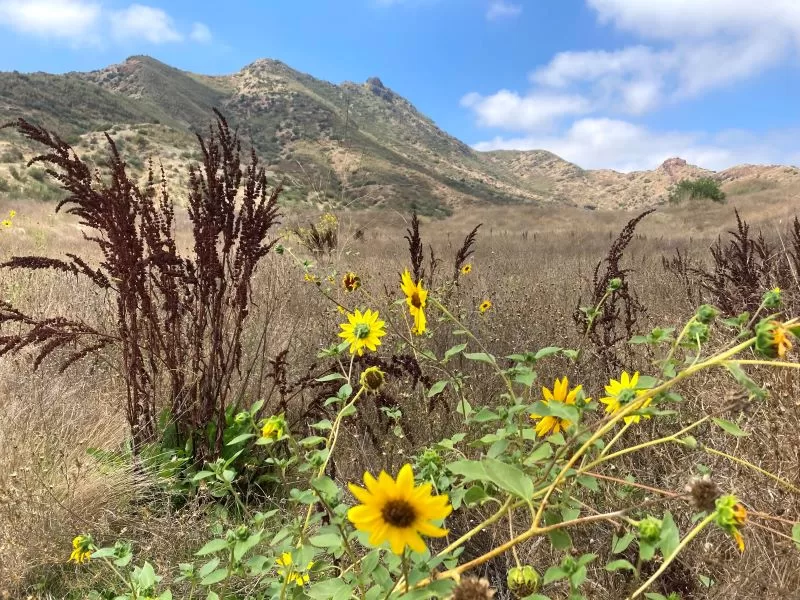
Topanga’s artists studio tour is back! We miss our Gallery but the newly organized Open Studios of Topanga won’t disappoint. Don’t miss this opportunity to meet and support local artists, explore their working spaces, and experience a one-of-kind journey into the artistic soul of the Topanga community. We have all the details on pages 10-11. Image by Robert Nickson on Unsplash. Cover design by Urs Baur
Autumn officially arrived on September 22, at the moment of the autumnal equinox. The change of seasons was marked this year by coastal fog and cooler temperatures, but the Santa Anas—the devil winds that drive Southern California’s cycle of wildfires—are coming. This fall marks the five year anniversary of the Woolsey Fire, and fire season this year has the potential to be equally combustive. We are sharing an open letter to the community from Woolsey fire survivor and emergency preparedness advocate Keegan Gibbs in this issue of Topanga New Times. Keegan is asking everyone who lives or works in the wildland interface of Topanga and the Santa Monica Mountains to take the time now to prepare. He reminds us that it isn’t a question of if, it’s a question of when.
The 39th California Coastal Cleanup Day is coming on Sunday, September 23. This annual event is now the largest volunteer event in the state. Clean-up opportunities close to home include Topanga State Beach and the Malibu Lagoon. To learn more or to sign up, visit www.coastal.ca.gov/publiced/ccd/ccd.html
The start of autumn marks the transition period from tropical storm systems that bring warm water and big waves from the southern Pacific, to colder systems that roll in from the North. An ominous new climate change study published in the Journal of Geophysical Research: Oceans, suggests that waves generated by those winter storms are getting bigger, and that big waves are becoming more frequent. That may be good news for big wave surfers, but it is potentially a big problem for coastal residents and critical infrastructure, like Pacific Coast Highway.

The study, based on seismic data, finds that wave size and frequency has significantly increased along California’s coast since the 1970s. It also suggests that the high level of storm activity throughout the North Pacific over the past winter wasn’t an anomaly so much as a harbinger of things to come. The California Coastal Commission and coastal communities up and down the state are struggling to come up with sea level rise guidance that doesn’t involve the unpopular concept of “managed retreat”—pulling back from the coast. The prospect of bigger waves further complicates an already contentious and complex issue.
Are there other worlds out there that have active oceans? The Webb Space Telescope may have found one. Instruments on the Webb have detected a cocktail of carbon dioxide and methane in the atmosphere of K2-18b, a “potentially habitable world” that is more than eight times the size of Earth, according to NASA.
“An abundance of carbon dioxide and methane (along with a shortage of ammonia) is intriguing to astronomers: It supports the idea that this planet may have a water ocean underneath a hydrogen-rich atmosphere,” an announcement on the discovery states.
“Webb also hinted at a detection of dimethylsulphide on K2-18b. On Earth, this molecule is only produced by microbial life. Because the detection needs to be confirmed, the team plans to follow up and look for additional evidence of biological activity on the planet.”
A California bill that would legalize the personal possession and use of certain psychedelic drugs was passed by the State Assembly earlier this month, and received Senate approval earlier this year. It is now on its way to the governor’s desk.
SB58 proposes decriminalizing the possession and cultivation of limited amounts of naturally occurring psychedelics, including mescaline, and psilocybin and psilocin—the psychoactive elements found in “magic mushrooms.” If the governor signs the bill, personal use of these drugs would be legal for adults 21 and older.
Anyone who has ever been to Denver, Colorado has seen the dramatic mountain that dominates its skyline. Mount Evans was named for disgraced nineteenth century territorial Governor John Evans, who was forced to resign for his involvement in the Sand Creek Massacre, an incident that involved the killing of 230 Cheyenne and Arapaho people in southeastern Colorado territory during peace negotiations. The mountain is now officially “Mount Blue Sky.” The new name was selected with the input of Cheyenne and Arapaho tribal leaders. It replaces an infamous name with one that evokes the mountain’s cultural and spiritual significance.
The renaming of Mount Blue Sky addresses an old and bitter injustice, and there are other efforts underway all over the country to restore indigenous names to landmarks and locations. There are many here who would like to see more elements of the Santa Monica Mountains National Recreation Area named to reflect our Chumash and Tongva cultural heritage, instead of the trend for naming trails and parks for politicians and real estate developers. Names are important. They should be chosen with care.
Stay safe, be well. Happy autumn!













